Book contents
- Frontmatter
- Contents
- Preface
- Acknowledgements
- 1 Geomorphology and the Great Barrier Reef
- 2 Foundations of the Great Barrier Reef
- 3 Sea level: a primary control of long-term reef growth and geomorphological development
- 4 Oceanography, hydrodynamics, climate, and water quality as influences on reef geomorphological processes
- 5 Spatial analysis of the morphology of the reefs and islands of the Great Barrier Reef
- 6 The non-reefal areas of the continental shelf
- 7 Fringing and nearshore coral reefs
- 8 The mid-shelf reefs of the Great Barrier Reef
- 9 The coral reefs of the outer shelf of the Great Barrier Reef
- 10 Islands of the Great Barrier Reef
- 11 The accumulation of the Holocene veneer to the Great Barrier Reef
- 12 The Holocene evolution of the Great Barrier Reef province
- 13 Geomorphology's contribution to the understanding and resolution of environmental problems of the Great Barrier Reef
- References
- Geographic index
- Subject index
9 - The coral reefs of the outer shelf of the Great Barrier Reef
Published online by Cambridge University Press: 22 August 2009
- Frontmatter
- Contents
- Preface
- Acknowledgements
- 1 Geomorphology and the Great Barrier Reef
- 2 Foundations of the Great Barrier Reef
- 3 Sea level: a primary control of long-term reef growth and geomorphological development
- 4 Oceanography, hydrodynamics, climate, and water quality as influences on reef geomorphological processes
- 5 Spatial analysis of the morphology of the reefs and islands of the Great Barrier Reef
- 6 The non-reefal areas of the continental shelf
- 7 Fringing and nearshore coral reefs
- 8 The mid-shelf reefs of the Great Barrier Reef
- 9 The coral reefs of the outer shelf of the Great Barrier Reef
- 10 Islands of the Great Barrier Reef
- 11 The accumulation of the Holocene veneer to the Great Barrier Reef
- 12 The Holocene evolution of the Great Barrier Reef province
- 13 Geomorphology's contribution to the understanding and resolution of environmental problems of the Great Barrier Reef
- References
- Geographic index
- Subject index
Summary
Introduction: shelf-edge morphology
The gently sloping continental shelf on which the Great Barrier Reef (GBR) is situated starts to steepen at depths between 40 and 50 m. In the far north the change of slope is rapid and coral reefs are located on the very edge of the drop-off. Along the central GBR the slope is more gentle and this section of the outer shelf is dominated by submerged reefs which only rarely reach the sea surface. The outermost reefs of the south central GBR are the massive Pompey Reefs which appear to be located on the shelf edge but which have been shown more recently (Hopley, 2006) to be on the highest of a series of shelf-edge steps descending to ∼80 m, at which depth the shelf drops away steeply. Distinctive shelf-edge reefs are not found around the Swain Reefs nor opposite the southernmost Bunker–Capricorn reefs.
A feature of all the shelf-edge reefs is that they are linear and parallel to the contours of the shelf. Even the large Pompey Reefs are aligned parallel to the shelf-edge bathymetry, have a series of submerged linear reefs to seawards, and contain linear features which are persistent along the entire complex. The best known of the shelf-edge reefs are the ribbons of the northern GBR. Fairbridge (1950, 1967) suggested that they represent the upgrowth of fringing reefs established at lower sea levels and all the evidence suggests that this is very probable, not just for the ribbons but also for all the shelf-margin linear reefs which are discussed in this chapter.
- Type
- Chapter
- Information
- The Geomorphology of the Great Barrier ReefDevelopment, Diversity and Change, pp. 271 - 310Publisher: Cambridge University PressPrint publication year: 2007



